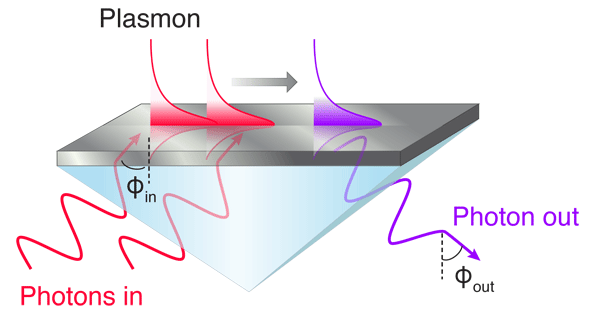3 ways to become invisible
Metamaterials, Plasmonics and Holograms explained...
You can’t depend on your eyes when your imagination is out of focus.
- Mark Twain
Greetings, fellow Bohron
If there exists one superpower that we all want to possess someday, it has to be invisibility. I mean, who wouldn’t want to use this technology for personal gain, given the mean nature of us humans? A person armed with a cloaking device would be able to hurt enemies undetected and maybe rule the world according to his/her own selfish purposes.

A real-life cloaking device that renders anything completely invisible to all forms of electromagnetic radiation is still a dream. However, recent developments in nanotechnology, optics, electrical engineering, and material science have produced major breakthroughs in our quest to make things invisible.
The good news is, we have already created them in modified forms. Yes, cloaking devices kind of exist! So, how to build a cloaking device? Here I’ll talk about three techniques that are being seriously studied and developed by researchers. But first, let’s look at how cloaking devices have been showcased in science fiction.
Invisibility in Sci-Fi
The first name that comes to my mind while talking about invisibility is H.G. Wells’ all-time classic, The Invisible Man. Griffin, a young medical student, develops a way to alter his refractive index to that of air, making him entirely invisible. Wrapped in bandages, he is driven insane and becomes a dreaded criminal.

In the Harry Potter series, donning the invisibility cloak allows Harry to roam Hogwarts Castle undetected. In Mr. India, Arun’s cloaking device is a magical wristwatch invented by his father, which, when activated, makes its wearer invisible. Another notable depiction is the ‘ring’ from the Lord of the Rings, which grants its wearer the power of invisibility.
Metamaterials
A metamaterial is any artificially engineered material with unconventional properties not found in nature.
The natural properties of a material are deliberately and consciously altered by introducing tiny implants into a substrate. This exploitation of the properties causes metamaterials to interact with electromagnetic radiation in unnatural ways.

A property that determines the behaviour of light in a particular medium is the refractive index.
The refractive index(n) of a medium is defined as the ratio of the speed of light in a vacuum(c) to the speed of light in that medium(v).
For any conventional material, n > 1 because light travels fastest in a vacuum.
Materials with negative refractive index were first introduced in theory by Soviet physicist Victor Veselago in 1967. Metamaterials have a negative refractive index, which means that they cause the light to bend around their surface without causing reflection, making them a viable option to create a real-life cloaking device.

A conventional lens is composed of a single, continuous material with a uniform refractive index. In metamaterials, tiny implants with different refractive indices are embedded at different sites. This way, the light gets manipulated by each implant in a specific manner. If we can remove all the reflections and shadows, the object becomes completely invisible to that radiation.
The first breakthrough for creating a cloaking device using metamaterials came in 2006 at Duke University, New Carolina, when a group of researchers fabricated a material that rendered objects invisible to microwave radiation.

Then in 2007, researchers at Ames Laboratory, Iowa and Karlsruhe Institute of Technology developed the first-ever metamaterial operating for the red light. It consists of a layer of magnesium fluoride sandwiched between layers of silver over a glass sheet forming a fishnet-like structure and has a refractive index of -0.6.
The materials implanted must be smaller in size than the wavelength of the radiation being used to observe them. For visible light, whose wavelength ranges from 380 nm(for blue) to 700 nm(for red), we need to create nanomaterials which is not an easy task to accomplish. We have begun to tackle this problem only recently and the progress has been slow but appreciative. Hopes are high.
Plasmonics

In 2007, researchers at the California Institute of Technology invented a metamaterial with a negative refractive index for blue-green light, using a new technology called plasmonics. They sandwiched a silicon-nitrogen wafer between layers of silver, forming a structure that was capable of manipulating incoming radiations in a particular fashion.
Plasmonics uses Nanotechnology, Quantum Mechanics, Solid State Physics and Optics to squeeze light up to nanoscales to manipulate nanomaterials. The main aim of plasmonics is to create computer chips that process information using light rather than electricity.

When a metal surface is stimulated by light, loosely bound electrons on the surface start vibrating in unison with the frequency of the light used. This collective excitation sets up harmonic oscillations in the electrons known as plasmons. So by squeezing plasmons to vibrate with the frequency of the original light, these waves can be crammed into nanowires.
Research in such techniques would allow us to develop better metamaterial fabrication techniques boosting the research of invisibility cloaks.
Holograms

A clever way to achieve invisibility is to photograph the background behind the person and project it on a screen placed in front. This way, all that an observer sees is a continuous background minus the person. However, since the image is produced on a 2D screen, it doesn’t change if you slightly move your eyes, telling that it’s fake.
The solution to this problem is to create images using a technology known as holography.
A hologram is a 3D projection of an image/video reconstructed using lasers. Dennis Gabor, who won the 1971 Nobel Prize in Physics, is regarded as the Father of Holography.

Just as described above, if the background behind an object is reconstructed using a holographic camera and then produced onto a holographic screen, the object would become invisible. Even if you move around the object, you won’t be able to tell any difference.
A major difficulty faced in holography is the computational power required to reproduce an image onto the screen. To print a realistic image, we need a large number of sampling points of an object, store and process the information, which leads to an enormous increase in the computational power.

As magical as this superpower is, it’s no surprise scientists all across the globe have jumped into the race to build a cheap, efficient material for cloaking devices. Ten such amazing invisibility cloak technologies are discussed in a video by Paradigm. Watch it here.
Given the significant progress already made despite the difficulties encountered in nanotechnology, most researchers believe that some sort of invisibility would be commonplace by the end of this century.
Sources:
The Invisible Man - H.G. Wells
Physics of the Impossible - Michio Kaku
Metamaterials Explained Simply and Visually - Duke University
First Demonstration of a Working Invisibility Cloak - Duke Today
Metamaterials Found To Work For Visible Light - Science Daily
Researchers time plasmon-generated electrons moving from nanorods to graphene - Physics.org
Tech + knowledge + Y: What is a hologram? - Georgia Tech




